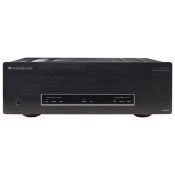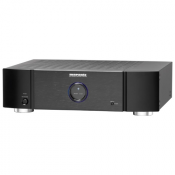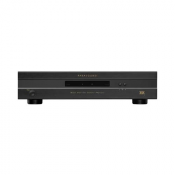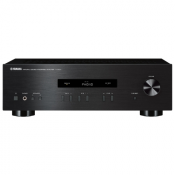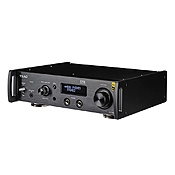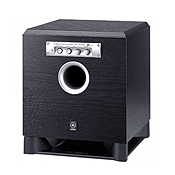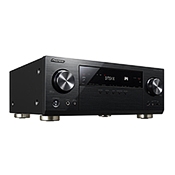Yamaha A-S801
Short review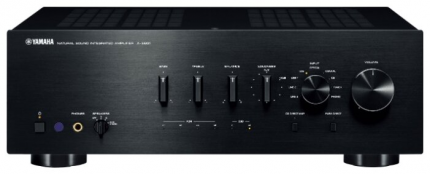
Selected in the rating
5
Best rating
sound amplifiers
Power per channel: up to 200 W - Type: Integrated amplifier
Buy Yamaha A-S801
Yamaha A-S801 specifications
Yandex.Market data
| General characteristics | |
| A type | integrated amplifier, stereo |
| Number of channels | 2 |
| Circuit design | semiconductor |
| Amplifier parameters | |
| Front channel power | 160 W (4 ohms, 1 kHz, 0.7% THD), 100 W (8 ohms, 20 Hz - 20 kHz) |
| Front channel peak power | 290 watts |
| Recommended load resistance | 4 - 8 Ohm |
| Reproducible frequency range | 10 - 100,000 Hz (+/- 1 dB) |
| Harmonic coefficient | 0.019% (50 W, 8 Ohm) |
| Signal to noise ratio | 104 dBA |
| Damping factor | 240 |
| Line in / out | |
| Sensitivity | 200 mV |
| Input impedance | 47 k Ohm |
| Output voltage | 200 mV |
| Output Impedance | 1 kΩ |
| Phono stage | |
| Phono stage | yes, MM |
| Sensitivity (MM Pickup) | 3 mV |
| Signal-to-Noise Ratio (MM Cartridge) | 82 dBA |
| Adjustments | |
| Balance adjustment | there is |
| Tone control | there is |
| Bass tone control range | 10 dB |
| Treble tone control range | 10 dB |
| Loudness | there is |
| Digital audio processing | |
| DAC | yes, 192 kHz / 32 bit |
| Interfaces | |
| Inputs | coaxial x1, optical x1, linear x5, Phono |
| Outputs | subwoofer x1, headphones x1, line x2 |
| Interfaces | USB Type B |
| Front panel connectors | headphones |
| Headphone jack | 6.3 mm |
| Connectors for acoustics | screw |
| Gold plated connectors | there is |
| Functions | |
| Direct mode | there is |
| Connecting additional sets of acoustics | there is |
| Food | |
| Power Supply | built in |
| Design | |
| Dimensions (WxHxD) | 435x152x387 mm |
| Weight | 12.1 kg |
| Additional Information | |
| Remote control | there is |
| Features: | USB-A connector for powering external components |
Yamaha A-S801 reviews
Yandex.Market data
Advantages:
- Good sound, with great detail, balance and awesome scene. It does not fail even with orchestral music, the bass does not protrude, the mids and highs are very clean. I only listen to Pure Direct. - Adequate power reserve for medium-sensitive acoustics, I usually listen with the volume control at 9-10 o'clock, if more than 12 - it's already too loud for my ears. Well, I don't want to swear with neighbors :) - A good DAC with all the necessary inputs - USB, optics, coaxial. For not super picky use, it will suffice. - Surprisingly adequate driver (at least for Windows). It is installed without problems, it is prescribed where necessary, there is a buffering setting, when the amplifier is turned on, the sound goes only to it, when it is turned off - to another output when it is present. There is even a mini-instruction for working with Foobar. - There is a separate output to the subwoofer (but see disadvantages). - Easy-to-use tone controls. - Adequate indication, LEDs show the selected input, USB DAC frequency, direct modes. Noticeable, but not too bright, as sometimes happens. - When you plug in headphones, the sound from the speakers is skipped automatically - High-quality-looking interchange inside. - Solid and heavy transformer. - Overall nice retro design.
Disadvantages:
This is rather nit-picking, which is lacking for the ideal. - No stereo pre-outs, if you have a DAC, they can come in handy. - The pre-out of the subwoofer is implemented according to a curved scheme - in any case, the entire spectrum goes to the speakers, and only everything below 90 Hz goes to the subwoofer line. As a result, the bass plays both there and there. For cinema, of course, this is even good, but for music - not an option at all. You have to keep the subwoofer off and turn it on only when watching movies. - The remote control is not the most convenient, all buttons are of the same shape and size, it is unrealistic to use in the dark. Adjusting the volume from the remote is a tedious task.- The notch on the volume control could have been more noticeable, or there might have been some kind of indicator. From a distance it is not visible at all what volume level. - Mute does not turn off the sound completely, but puts it at about -20 dB from the current one. - A plus in the detail and balance of the sound for someone can be a minus, he will say that the sound is dry and lifeless. Everyone has different ears and habits, some prefer warm treble and / or more pronounced bass. Be sure to listen to the equipment before purchasing, if possible. Or at least read the reviews carefully. This is already a minus: - A week after use, the volume control failed. He behaved as inadequately as possible, the sound could go at the zero position, change itself, react to the turn of the knob in reverse. When using the remote control, the picture is approximately the same. I brought it to the store, the sellers clicked their tongues, how lucky I was, and gave the same device for replacement. As long as pah-pah everything is in order.
Comment:
Before that, I had a purely cinematic set of Yamaha RX-V671, Jamo S606 and Velodyne Impact-12. Now, due to a number of circumstances, the priority is music, less cinema and games, but I did not want to throw them at all. In the end, this amplifier turned out to be an excellent option. Works in tandem with Dynavoice Definition DF-8 speakers. Connected to a PC via USB, to a TV via optics. The TV acts as an HDMI receiver for set-top boxes and game consoles. The sound in music cannot be compared with the previous version. With acoustics, they produce a very clean, transparent, balanced and surround sound. In a word, honest. Who will choose according to the reviews - look at the A-S700, A-S701 - the analog kit and the path are almost identical. The only difference is in the availability and functionality of the DAC. The impression was slightly spoiled by the defect of the volume control in the first copy (see disadvantages). I hope that the marriage is single, and then everything will be fine. Now I will save up and choose a source for supplying analogue to an amplifier in order to completely decouple the music.
November 22, 2015, Yekaterinburg
Advantages:
Built-in DAC and the ability to connect by digital (Coaxial, optics, YUSB) Plays all modern formats by digital. Power of the Brand No feeling of spent money, only the feeling of purchase.
Disadvantages:
It is not visible in what position the volume knob (when controlled from the remote control, it rotates) Outwardly, at first, we did not like the "proprietary" Yamaha knobs for controlling the timbre block. However, in practice it turned out that they are very convenient and informative. I supplement after 4 months of use: 1. It is a pity that there is no control of loudness from the remote control. often this regulator is needed as the main volume level (well, rather, this is not a drawback, but a wish for the design).
Comment:
Finally, I became the proud owner of this device (black). Long chose what to take a receiver or amplifier. I chose between this amplifier and the Yamaha RX-V777 receiver. I really wanted to be able to send a digital signal directly to the device itself. As a result, I took the amplifier. all the same, the quality of the amplifier will always outplay the receiver. Surround sound was unnecessary. The aim was precisely to listen to music, and cinema in good stereo is enough. In short, the device is very satisfied. The device met all expectations and even more. I connected it via USB to a computer and all content from the computer goes digitally. The speakers are JBL E50 bookshelf speakers. I was pleased with the adjustable LOUDNESS, a very cool thing for listening at low volume. It is difficult to explain in words, you need to listen, but in general it removes the middle and the sound becomes, as it were, voluminous and the lows become more expressive. The detail is excellent. The background in the AU is not observed AT ALL !!! Yes, the device is very powerful for a small-sized room. At half the volume, you will hardly ever have to listen (but the stock, as they say, "does not pull ...."). At low volume listening to music in DIRECT is not ice, there is a lot of middle, I use loudness, it corrects the situation by 5+. There are few reviews on the Internet, I made a choice based on reviews about the A-S700 and A-S701. In short, I recommend a worthy device to everyone. I took it in the "well-known Internet shop" for 36990 rubles (do not count it for advertising .....but the sellers there are not boys, but adults and understanding men) The unpacking of the device is posted on YouTube, look under the name: Yamaha A-S801 unpacking Complement after 4 months of use: The device is not disappointed. I was convinced of the absolute correctness of the choice. As I already wrote in the shortcomings: lacks LOUDNESS control from the remote control. I practically don't use the timbre block LF and HF. I only use LOUDNESS. The frequencies at the middle position of the bass and treble knobs are quite enough; nothing needs to be added or subtracted.
February 5, 2016, St. Petersburg
Advantages:
clear transparent sound, excellent dynamics, collected bass
Disadvantages:
no classic USB input
Comment:
Powerful amplifier with excellent acoustics control. Works with Dali Ikon 6MK2. Provides clear, rich sound in CD-direct mode. Not every amplifier can handle Dali, obviously due to the high dumping factor, Yamaha does its job playfully. A very useful thing is the built-in DAC; for the first time I listened from a cheap blue ray player through a coaxial input. When choosing, I compared it with NAD (I don’t remember the model worth 125,000 rubles) and Cambridge Audio cxa 80 with the same speakers; Yamaha turned out to be out of competition (taking into account the cost of 50,000 rubles). Special thanks to the developers for the adjustable loudness - an irreplaceable thing at low volume.
December 14, 2017, Moscow
Advantages:
Excellent DAC with support for DSD64 and DSD128. High power output. Versatility in terms of reproducible material. All terminals including acoustic, "gold plated". The volume knob and input selector are aluminum. Adjustable loudness. Acoustics resistance switch.
Disadvantages:
Plastic tone control knobs. Not all overlapping functions work for the CD-N500 and A-S801 remotes, sometimes it's inconvenient.
Comment:
In the apartment he is cramped, very powerful, but there is no excess power. After half a year, it seemed to have warmed up, the bass became more weighty, removed almost to zero. This device definitely costs its money.
July 22, 2015, Abakan
Advantages:
I am one of those who just listen to music, and do not catch squeaks, sighs, an extra violin, etc. I had several more expensive amplifiers, but the 801th beat them all, it sounds great to me, and the low and high (the tone block and subtle compensation will adjust the sound to every taste - (audiophiles aside). I use it with 250 warfs, source denon1520. I didn't bother with wires and interconnects.In general, that's the thing for me (by the way, the sub is not needed, there is enough bass)
Disadvantages:
haven't found yet
Comment:
March 18, 2018, Elektrostal
Advantages:
Great built-in DAC, good amplifier path, excellent functionality - no better choice for the price.
Disadvantages:
I use 1.5 months until I found it.
Comment:
10 March 2015
Advantages:
An ideal solution in terms of price and quality, I think it makes no sense to take more expensive amplifiers for an average apartment.
Disadvantages:
They are not
Comment:
Before this amplifier, the yamaha avantage a-810 receiver, after two years of use, broke down without the possibility of repair. The sound from the amplifier is several times different from the sound from the receiver. The music scene has become more detailed. When watching movies, it is possible to use the sub, since there is a plug for the plug. I listen to music without a sub, only if it's not club music. It is advisable to have a good CD player as a source. In general, it took a long time to reach a stereo solution! And even more importantly, this amplifier, with its powerful sound, allows my neighbors who live two floors above and three floors below to listen to music !!!
December 17, 2016, Cheboksary
Advantages:
appearance, power, built-in DAC, reproduces all modern formats digitally, and most importantly, sound quality.
Disadvantages:
no
Comment:
Yamaha A-S801, paired with DALI Opticon 2 speakers.
6 August 2020, Moscow
Advantages:
Great sound, high quality DAC
Disadvantages:
not found
Comment:
I bought to replace the YAMAHA RS-700 receiver. Surprisingly, the amplifier sounds much better than the receiver, although the circuitry and the declared characteristics of the devices are almost the same. I use Monitor Audio Bronze 6 with acoustics. As a sound source I use a Yamaha NP-S303 network player (connected via optics) and a Yamaha CD-S700 CD player (connected to an analog input). I am very pleased with the quality of the DAC built into the amplifier. Because of the DAC, I chose the AS-801, not the AS-701. I compared the connection of a network player by analog and digital, so the DAC built into the amplifier sounds much better in digital, but when comparing the CD player, I did not reveal any advantages noticeable by ear, so I decided to use the DAC built into the CD player. The overall sound of the amplifier, together with my acoustics, will be characterized as balanced, with a slight emphasis on the upper register. You don't even need to adjust timbres and tone compensation. I will note a noticeable improvement in sound in Pure Direct mode. In this mode, there is more detail in the upper and middle registers. I couldn't tell the difference between CD DIRECT and PURE DIRECT modes. The power reserve for my acoustics is very large, there is no need to turn the volume over 10-11 hours. In general, I am satisfied with the device, I recommend it for purchase.
July 28, 2020, Dolgoprudny
Advantages:
This model is equipped with a DAC, has a fairly solid power, the ability to play high-resolution audio files from a computer via USB, juicy bass, from the remote you can control some functions of other Yamaha devices, such as a CD player.
Disadvantages:
Initially I bought a silver model, it turned out to be defective (I did not expect this from Yamaha) - on the second day of testing, a dip in high frequencies was found on the left channel, not very obvious, but nevertheless, as a result, sound distortion and a skew of the music scene to the right, to silver could not be changed, it was not available (in a large market - I can't say where, then the review will be rejected, and so I rewrite it for the fourth time :-)), only for the black one, which was auditioned on another well-known market (here the word " store ":-)), working in cooperation with that first large market (which I was forbidden to mention under the threat of not publishing a review :-)), such a defect was not found on the black model, and it looks more impressive, I wanted to take the silver one only from - for compatibility with the silver multichannel receiver DK Onlyo I already have, well, in general, I took the black one in the end. I also consider the disadvantages: 1) the lack of a Pre Out connector, respectively, the use of front speakers in a home theater system becomes extremely inconvenient; 2) there are no scale divisions and fixed positions (except for the vertical one) of the bass and treble adjustment knobs - VERY inconvenient; 3) the distance between the buttons on the remote control is very small, you can easily press the wrong button by mistake, ergonomics are not well thought out.
Comment:
In general, the sound is very good, the bass is pleasing, so despite the shortcomings, you can safely put four points. I would especially like to thank the specialists from the well-known market (see the comment above :-) :-) :-)), they organized listening to this amplifier on various acoustic systems, replaced the defective model, helped to test the replacement amplifier and, in general, showed understanding and were attentive to my situation.
August 22, 2019, Moscow
